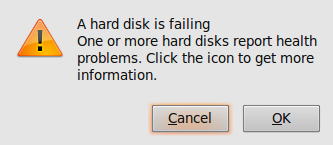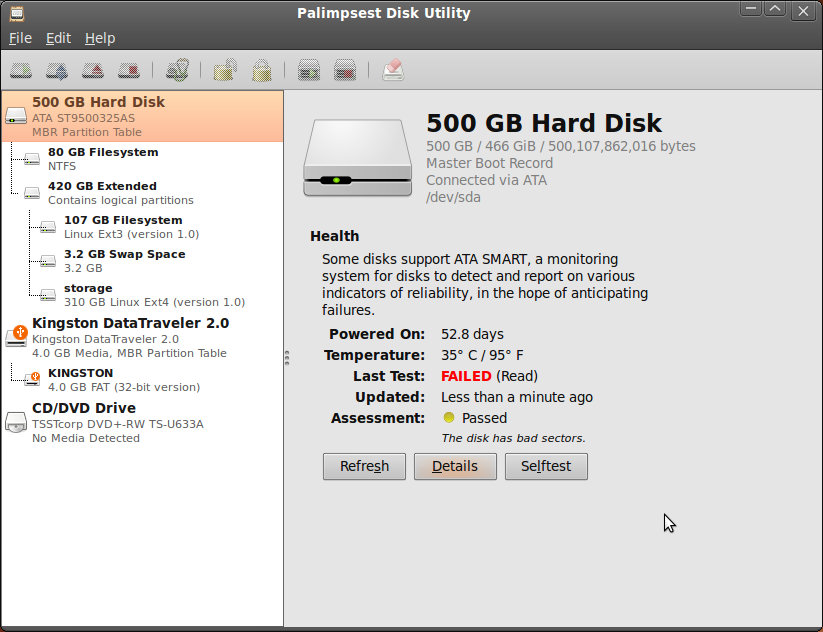I started to write a blog post about my backup solution, but didn’t actually finish it before this happened. I only got it running on Wednesday this week, when today my laptop (running Ubuntu 9.04) refused to boot! I was getting a lot of I/O and “DRDY ERR” error messages. The boot process mounted the drive read only, dropped me to a shell and told me to run fsck manually (not terribly helpful for inexperienced users I might add).
Anyway, instead of doing that I elected to reboot from a flash drive with 9.10 alpha6 on it, and examine the disk from a properly working system. After booting Karmic, I was greeted with the following message:

How thoughtful!
The “icon” it’s referring to is a little disk icon in the top right of the screen with an exclamation mark on it. Clicking on it brings up the new Palimpsest Disk Utility – a nice step forward from 9.04, which only included gparted. There’s not really anything wrong with gparted, but its main focus is on partitioning and it doesn’t have other disk management features such as SMART monitoring. And Palimpsest does present a nice interface:

Bad sectors are not a good sign, so it would seem that this not-very-old 500gb hard drive is on the way out.
To “repair” the bad sectors (i.e. make sure the filesystem doesn’t use them), I ran “fsck -c /dev/sda5” (sda5 is my root partition, the one that was giving me trouble). This runs the filesystem check in conjunction with the badblocks tools. For now it’s up and running again, but I’ll be replacing the drive and restoring my data before sending it off for RMA!
It looks like I won’t need to go back to a backup, but this certainly shows the value of regular backups and when my laptop failed to boot I was extremely glad I had them!
Ubuntu 9.10 beta is only a week away, and so far “Karmic Koala” is shaping up to be a solid release.

You are one of the lucky ones: you disk actually was bad, in addition to seeming bad. Pampliset, despite having a nifyt user interface, doesn’t seem to do a very good job of predicting disk failure. If you look at the bug reports, you’ll find that lots of false positives. Google did a study of SMART parameters, and concluded that while they had some predictive power, they really were not good enough to usefully predict disk failures. (I.e. the best statistical analysis Google could do would make many false predictions of failure, and that disks could run for a year or more while the best algorithms were predicting immediate failure.)
Palimpsest, internally, is not statistical software. So, you should (generally) not takes its warnings seriously.
Interesting, thanks. I think for something like bad sectors I would still take it seriously, but it seems you do need to look at what you are being warned about before jumping to conclusions. I’d be interested in seeing a link to that study if you have it?
Hi there,
This was the paper I am guessing he was talking about labs.google.com/en//papers/disk_failures.pdf